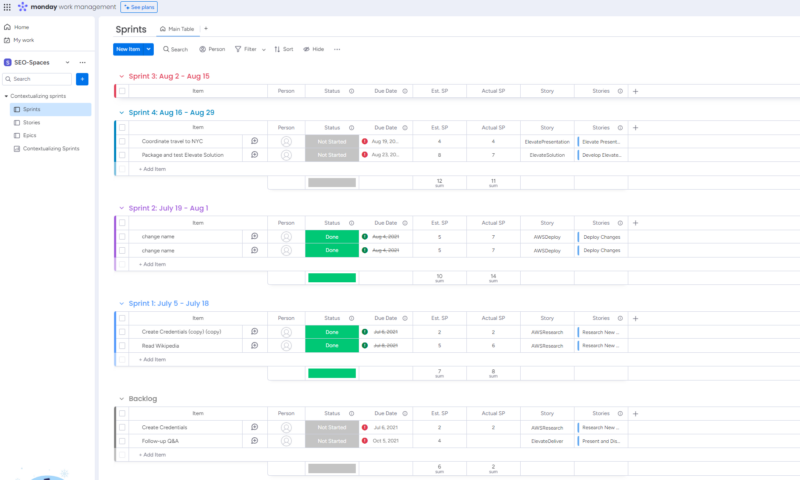
Why you can trust us
- 407 Cloud Software Products and Services Tested
- 3056 Annual Software Speed Tests
- 2400 plus Hours Usability Testing
Our team of experts thoroughly test each service, evaluating it for features, usability, security, value for money and more. Learn more about how we conduct our testing.
Key Takeaways: What Is Extreme Project Management?
- XPM is traditionally used in software development and programming, but it can be used in a range of other industries.
- Whereas traditional project management is more methodical, XPM is fast-paced and often chaotic.
- Because XPM is mentally demanding, it’s important to create a supportive environment for each team member.
Facts & Expert Analysis: Extreme Project Management
- Hire experienced managers: Because XPM is a high-intensity approach to projects, we recommend hiring a project manager with vast experience in fast-paced environments who has also worked with very demanding stakeholders.
- Build an open-minded team: When it comes to work, some team members like structure and others bring a go-with-the-flow attitude. In XPM, the latter will benefit you most when it comes to project success.
- Log meetings: Due to the ever-changing nature of XPM, plus the constant meetings and reviews, it’s a good idea to record as much information as you can. That way, you can refer back to it should you need it. For example, services like Google Meet let you record your sessions.
Extreme project management (XPM) is a fast-moving approach to completing projects. It’s the polar opposite of traditional project management, and in this article, we will highlight the differences and show you how to achieve the best project management outcomes by implementing XPM.
Extreme project management is a framework you’ll find within Agile project management. It’s become more popular in modern projects, partly because clients and stakeholders are more involved with the project lifecycle. Their influence often leads to changes in the project plan, and XPM is a good way to react and complete work much quicker where needed.
In this article, we’ll break down the fundamentals of extreme project management. We will also highlight the best time to use XPM while sharing some of its advantages and disadvantages. If you’re looking for extreme project management tools for software development projects, then check out the best Agile tools on the market.
Meet the experts
Learn more about our editorial team and our research process.
What Is Extreme Project Management? Meaning Explained
Unlike other production processes such as JIT (just-in-time), it’s unclear when extreme project management was first introduced or who the mastermind behind the framework was. We do know that the first organizations to implement this approach were centered around software and technology development projects. However, in theory, any industry can use XPM.
Project Management
Check out our project management courses and grab a limited-time offer.
Registration available now!
Enroll Now
At the risk of sounding like a spiritual guru, XPM is less about the work and more about how you manage personalities, emotions and thought processes during difficult stages throughout a project.
Essentially, an extreme project manager will react to stakeholder concerns, adapt project strategy and resolve issues quickly to ensure the project is complete. This may all sound a little vague, so we’ll share some of the characteristics of extreme project management below.
Extreme Project Management Methodology: Characteristics
Characteristics are essentially the approaches and mindset you need to implement XPM. They include the following:
- Trial and error approach
- Adaptability
- The ability to work in a chaotic environment
- The capacity to work at a fast pace
- The willingness to work without a defined project goal
Extreme Project Management vs Traditional Project Management
By placing extreme project management and traditional project management side by side, we will now highlight their key differences. The Project Management Institute has this to say on the more traditional approach: “…most traditional project managers have been trained to follow a rigid set of defined processes.”1
This view further emphasizes the often inflexible nature of traditional project management. In contrast, extreme projects tend to be more akin to Agile ways of working as they are hyperflexible. Here are some more key differences.
| Extreme Project Management | Traditional Project Management |
|---|---|
| A fast-acting, hyperadaptable approach to managing projects | Involves methodical management of the project team |
| Tends to change paths depending on the demands of project stakeholders | Includes a defined project mission, which is designed before the project begins and is seldom adapted |
| Ignores hierarchy in order to adapt the project plan | Has a fixed hierarchy or organizational structure |
| Focuses on managing mindsets and thought processes | Focuses heavily on task management |
| Future-oriented | Tends to be past-oriented |
| Involves working on highly complex tasks | Includes more streamlined, easy-to-understand tasks |
Extreme Project Management: Steps & Techniques
The general consensus is that there are seven definitive steps to extreme project management. Below, we will highlight what each step is along with its role in the overall XPM lifecycle. The seven steps are as follows:
- Produce project plans: Although plans aren’t the foundation of XPM, it’s still good to have a rough idea of the direction you want to take. You can do this while also acknowledging that project plans are subject to change as a project progresses.
- Answer Extreme Project Management XPM questions: Project leaders and their teams must be able to answer these kinds of questions: Who needs the product? How can you build it? Do you have the required resources to complete the project? Is the project worth it for all involved?
- Create short work cycles: Short work cycles tend to last only a matter of weeks. It’s important to plan what work the team will complete within this timeframe and for what purpose. In Agile projects, such cycles are referred to as sprints, and they require ongoing sprint reviews and management.
- Host a project kick-off meeting: Once your resources are confirmed and you have a rough project plan, it’s a good time to hold a team meeting. This helps everyone determine if they’re on the same page. It also allows you to answer any questions before the work begins.
- Ensure continuous communication: Whether it be with the development team, creative departments or external stakeholders, keeping a high level of communication is essential in XPM. It helps you gather information, which you can use for continuous improvement and for sustaining commitment to delivering the best work possible.
- Hold frequent review sessions: Due to the evolving nature of XPM, holding frequent reviews allows you to check on project progress. You can also use them to implement a holistic approach to team management. XPM is high-stress, so it’s a good way to check on the team’s mental well-being and ensure that anti-patterns don’t start to creep in.
- Reflect: Once a project or short cycle is complete, reflect on the work you have done and celebrate any successes with your team through retrospective meetings. You can assess how well you did with your project goals, decide what works for future projects and see what can be left behind in the previous project.

Software like monday.com can help you plan short work cycles,
organize meetings and communicate with your team.
When to Use Extreme Project Management?
Although born out of extreme programming, XPM is widely used across several industries. The challenge is knowing when to use a more traditional management approach and when to ramp up the pace and go extreme.
Essentially, XPM works best in environments where project requirements often change. It’s also useful when you must complete short work cycles in a brief time period. This could happen when you’re working on a specific software feature or you need to make quick design revisions in interior design.
XPM can also be your knight in shining armor when things don’t go to plan. That’s because XPM doesn’t let you dwell on your issues; instead, you can react to them, keeping morale high and working quickly to find a solution. In other words, XPM is solution-focused and attempts to avoid encouraging a victim mindset.
Benefits of Extreme Project Management
Despite the heavy use of extreme project management among software development teams, it’s less about the tools you use and more about the people you work with. Using XPM has many advantages, as it helps you get your project team in the right frame of mind to do the best work.
XPM is very much about trial and error, which often leads to new, unpredicted positive outcomes. Since it’s fast-paced, such outcomes can happen quickly. These characteristics are great for moving projects forward and ensuring project success.
XPM also removes a defined hierarchy, instead asking team members to take leadership and responsibility. This gives team members the confidence to be independent. A decentralized structure helps remove hierarchical barriers that may prevent the full team from completing a certain section of work.
Finally, as XPM falls very much within Agile project management, it gives teams a high degree of flexibility. There’s no saying “no” in XPM, but rather an enthusiasm to adapt, redirect and ensure that the team does all it can to achieve the desired result.
Disadvantages of Extreme Project Management
The extreme approach isn’t perfect, and many of its benefits can also cause several issues. Take the trial and error approach, for example. Although it can have great success, it can also lead to catastrophic failures. This can push the project towards scope creep and hinder project completion.
Due to a rapid change in the project path, team members can quickly become disoriented, suffer a drop in confidence and struggle to maintain the high demand for productivity as a result. The fast pace also puts lots of pressure on team members to deliver work quickly without reducing the quality. For some, that pressure can be too much to handle.
A lack of hierarchy also has its downfalls. Without leadership and direction, a project can quickly turn into chaos if team members don’t take their own initiative, which will negatively impact both productivity and morale.
Final Thoughts
Now that you better understand extreme project management, it’s time for you to decide if your project can benefit from this approach. If you find that XPM doesn’t help you achieve your desired result, you have options. Take a look at our explanation of different project management methodologies, which describes what they are and what they can help you achieve.
What other project management approach would you like us to explain? Which project management approach do you prefer? Do you think XPM produces valued outcomes? Let us know in the comments. Thanks for reading.
FAQ: Managing Extreme Projects
-
Extreme project management is a fast-acting, adaptable approach to project management. Rather than having a long, drawn-out plan, project managers react to events as they arise.
-
The core phases of extreme project management are initiate, speculate, incubate and review. This is often referred to as the “INSPIRE” approach and was coined by Doug DeCarlo, the author of the book “eXtreme Project Management.”
-
There are many types of project management; in fact, there are far more than four. Popular types include traditional project management like Waterfall and the Critical Path Method, Agile and its frameworks (such as Scrum and Kanban), extreme project management and more.
Extreme project management is a fast-acting, adaptable approach to project management. Rather than having a long, drawn-out plan, project managers react to events as they arise.n”}},{“@type”:”Question”,”name”:”What Are the Phases of Extreme Project Management?”,”acceptedAnswer”:{“@type”:”Answer”,”text”:”
The core phases of extreme project management are initiate, speculate, incubate and review. This is often referred to as the u201cINSPIREu201d approach and was coined by Doug DeCarlo, the author of the book u201ceXtreme Project Management.u201dn”}},{“@type”:”Question”,”name”:”What Are the 4 Types of Project Management? “,”acceptedAnswer”:{“@type”:”Answer”,”text”:”
There are many types of project management; in fact, there are far more than four. Popular types include traditional project management like Waterfall and the Critical Path Method, Agile and its frameworks (such as Scrum and Kanban), extreme project management and more.n”}}]}]]>
Sources:
- https://www.pmi.org/learning/library/agile-challenges-traditional-project-management-6834
Let us know if you liked the post. That’s the only way we can improve.

